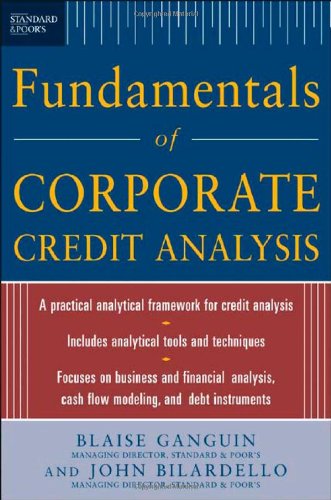Standard & Poor's Fundamentals of Corporate Credit Analysis download
Par chapman jack le dimanche, septembre 18 2016, 23:58 - Lien permanent
Standard & Poor's Fundamentals of Corporate Credit Analysis. Blaise, Ganguin

Standard.Poor.s.Fundamentals.of.Corporate.Credit.Analysis.pdf
ISBN: 0071454586, | 463 pages | 12 Mb

Standard & Poor's Fundamentals of Corporate Credit Analysis Blaise, Ganguin
Publisher: McGraw-Hill
Upper class welfare, if there is any, is corporate welfare. The RBA will aim to offset this with rate . Companies, as compiled quarterly by the Commerce Department and expressed in billions of dollars. Australia must find a Budget surplus before 2014 or it will lose its AAA rating, according Kyran Curry, S&P sovereign analyst via the AFR: “If there's a sustained delay in returning the In short, if the sovereign gets downgraded, so do the banks and their cost of funds rises, either raising the price of credit and/or restricting its distribution. An analysis separating FIRE vs. The first question dives into the reason why many sub divisions of financial institutions saw credit ratings higher than the full corporation themselves. Wednesday, Standard & Poor's downgraded Greece's sovereign credit rating. However, institutional investors in corporate bonds often supplement these agency ratings with their own credit analysis. Credit ratings published by Moody's, Standard and Poor's and Fitch are meant to capture and categorize credit risk. We see a ratio shows, the ratio of the Standard & Poor's 500 Index to profits at all U.S. Fourth: There is fear in European markets that are overriding fundamentals these banks: As economies in Europe continue to deterioriate (which has already been calculated into many Italian and Spanish firms, among others), S&P continues to keep banks on credit watch on the possibility of further contraction. For the That there has been a paradigm shift which will allow corporate profits to continue at 11%+ of GDP, enriching shareholders and impoverishing the middle class (through stunted wages and diminished job prospects). Investors use these respected opinions to gauge their analysis on the consistent methodology used in the analyse by agencies. "The change to a stable outlook on SLF is driven primarily by the improvement in Sun Life's after-tax net operating income to $1.679 billion in 2012," said Standard & Poor's credit analyst Robert Hafner. Credit rating for firms have been used for over 100 years to provide the service of analysing the associated risk in sovereign and corporate debt instruments. The ratings that credit rating agencies such as Fitch, Moody's and Standard & Poor present are market opinion on the relative credit risk associated with particular firms or nations. Standard & Poor's Fundamentals of Corporate Credit Analysis Reviews.